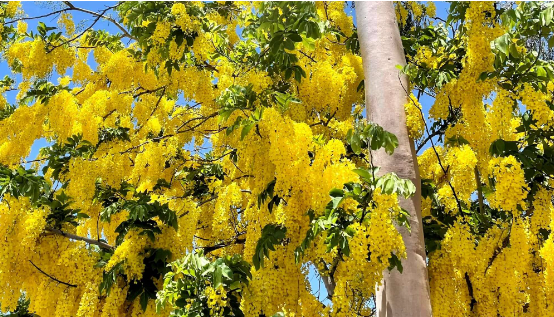
Facts
| Details | |
|---|---|
| Scientific Name | Cassia fistula |
| Common Names | Golden Shower Tree, Indian Laburnum, Pudding-Pipe Tree |
| Hardiness Zones | USDA Zones 10 and 11 |
| Light Requirements | Full sun to partial shade |
| Soil | Well-draining, fertile soil |
| Watering | Water regularly, but avoid overwatering |
| Fertilizer | Balanced fertilizer, applied every 2-3 months during the growing season |
| Pruning | Prune to maintain desired shape and size |
| Propagation | Stem cuttings or seeds |
| Bloom Time | Spring to early summer |
| Pests and Diseases | Generally pest-free, but can be susceptible to root rot if overwatered |
| Toxicity | Non-toxic to humans and pets |
History
The golden shower tree, also known as Cassia fistula or the Indian laburnum, has a rich history that spans several centuries. This beautiful tree is native to the Indian subcontinent and Southeast Asia, and it has been an integral part of the region’s culture, traditions, and medicinal practices.
The golden shower tree is the national flower of Thailand, where it is known as ratchaphruek. It was officially declared the national flower in 2001 due to its historical significance and its connection to the Thai monarchy. The tree is considered a symbol of honor, royalty, and prosperity in Thai culture.
In India, the golden shower tree is known as the amaltas, and it holds great importance in Ayurvedic medicine. The tree’s bark, flowers, and leaves have been used for centuries to alleviate various ailments, such as constipation, indigestion, and skin diseases. The tree’s medicinal properties include antibacterial, anti-inflammatory, and antioxidant effects, which help promote health and wellbeing.
The golden shower tree also has a strong presence in other parts of southern Asia, where it is known by different names like the purging cassia, the Indian laburnum, or the pudding-pipe tree. In these regions, the tree’s roots, bark, and leaves are used to treat a variety of health conditions, including dry coughs, bronchitis, and fever.
Throughout history, the golden shower tree has also been admired for its beauty and ornamental value. The tree’s bright yellow flowers and lush green foliage make it a popular choice for gardens and landscapes. In fact, its flowers have been described as “golden showers,” and the tree itself is sometimes referred to as the “golden shower tree” or “golden rain.”
Characteristics of Golden Shower Tree
- Appearance: It is a medium-sized tree that can grow up to 30 meters in height, with a wide-spreading canopy and a trunk that can reach up to 1 meter in diameter.
- Leaves: The tree has pinnate leaves that are arranged alternately on the branches. Each leaf can be 30-60 cm long and has 4-8 pairs of leaflets.
- Flowers: Golden shower tree produces bright yellow flowers that are arranged in long, pendulous racemes. The flowering season is typically from April to July.
- Fruit: The tree produces long, cylindrical seed pods that are initially green but turn dark brown when mature. Each pod can be 30-60 cm long and contains several seeds.
- Growth Rate: The tree has a moderate growth rate and can reach its full height in about 10-20 years.
- Lifespan: Golden shower tree can live for several decades, with some specimens reported to be over 100 years old.
USDA Hardiness Zones
The USDA Plant Hardiness Zones are a useful guide for gardeners and farmers to determine which plants are most likely to thrive in their region. These zones are based on the average annual minimum winter temperature, divided into 10-degree Fahrenheit zones.
For the Golden Shower Tree (Cassia fistula), it is a tropical plant that thrives in USDA Hardiness Zones 10 and 11, which are the warmest zones in the United States.
In the United States, the Golden Shower Tree can be grown in the warmest areas of Florida, California, and Hawaii.
How To Grow And Care For Gold Shower Tree
Planting Location: Choose a planting location that receives full sun to partial shade. The Golden Shower Tree thrives in warm and humid conditions, so ensure the location is suitable for its growth.
Soil: This tree prefers well-draining, fertile soil. If your soil is clay or sandy, consider amending it with organic matter to improve its fertility and drainage. The ideal soil pH range for the Golden Shower Tree is 6.0 to 7.5.
Watering: The tree requires regular watering to maintain soil moisture, especially during its early stages of growth. Water deeply and consistently, but avoid overwatering, as this can lead to root rot.
Fertilizing: Apply a balanced fertilizer every 2-3 months during the growing season to provide the necessary nutrients for healthy growth. Organic options like compost, manure, or bone meal can also be used.
Pruning: Prune the tree to maintain its shape and size, and to remove any dead or damaged branches. It’s best to prune in late winter or early spring before new growth begins.
Propagation: The Golden Shower Tree can be propagated through seeds or stem cuttings. For seed propagation, collect ripe pods from the tree and sow the seeds in a well-draining potting mix. For stem cuttings, take a 6-8 inch cutting from new growth and root it in a rooting medium like perlite or vermiculite.
Pests and Diseases: The tree is generally pest-free, but it can be susceptible to root rot if overwatered. Monitor for signs of disease and treat promptly if needed.
The unripened pods of the Golden Shower Tree contain a toxic substance called fistucacid, which can cause illness if consumed. Fully ripened pods and seeds are safe for consumption.